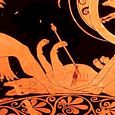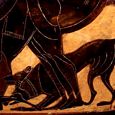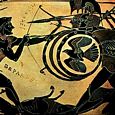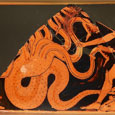ORTHROS
Greek Name
Ορθρος Ορθος
Transliteration
Orthros, Orthos
Latin Spelling
Orthrus, Orthus
Translation
Twilight (orthros)
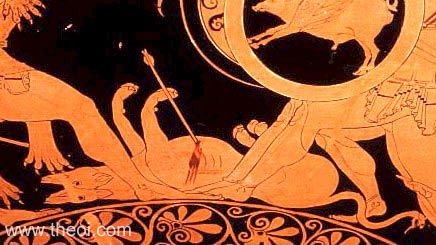
ORTHROS (Orthrus) was a two-headed, serpent-tailed dog which guarded the fabulous, red cattle of Geryon on the island of Erytheia. Herakles was sent to fetch these as one of his twelve labours and in the process slew both Orthros and his master.
Orthros was one of a large brood of monsters spawned the she-dragon Ekhidna. His siblings included the hound Kerberos (Cerberus) and the three-headed lion Khimaira (Chimera). With the latter the produced the Sphinx and the Nemean Lion.
Orthros' name was derived from the Greek word orthros meaning "Twilight". His name also spelt Orthos after orthos "the Straight".
FAMILY OF ORTHRUS
PARENTS
TYPHOEUS & EKHIDNA (Hesiod Theogony 309, Apollodorus 2.106, Quintus Smyrnaeus 6.249 & 260)
OFFSPRING
SPHINX, NEMEIAN LION (by Khimaira) (Hesiod Theogony 326)
ENCYCLOPEDIA
ORTHRUS (Orthros), the dog of Geryones, who was begotten by Typhon and Echidna. (Hes. Theog 293; Apollod. ii. 5. § 10.)
Source: Dictionary of Greek and Roman Biography and Mythology.
CLASSICAL LITERATURE QUOTES
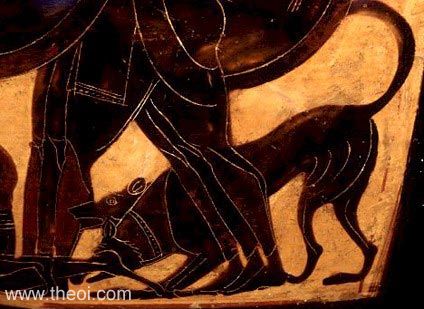
Hesiod, Theogony 326 ff (trans. Evelyn-White) (Greek epic C8th or C7th B.C.)
:
"But she [the Khimaira (Chimera)] in love with Orthos (Orthrus), mothered the deadly Sphinx . . . and the
Nemeian lion." [N.B. The mother of the Sphinx is either the Khimaira (Chimera) or Ekhidna (Echidna),
depending on how one interprests the "she" at the beginning of this passage. The leonine Khimaira,
however, is the likeliest candidate.]
Hesiod, Theogony 309 :
"First she [Ekhidna (Echidna)] bore him [Typhon] Orthos (Orthus), who was Geryones' herding dog."
Hesiod, Theogony 293 ff :
"[Herakles] killed Orthos and the oxherd Eurytion out in that gloomy meadow beyond the fabulous Okeanos
(Oceanus)."
Pindar, Isthmian Ode 1 ep 1 (trans. Conway) (Greek lyric C5th B.C.) :
"Alkmene (Alcmena) bore that dauntless son [Herakles], to whom long since the fierce hounds [i.e.
two-headed Orthros] of Geryon yielded in trembling terror."
Pseudo-Apollodorus, Bibliotheca 2. 106 - 108 (trans. Aldrich) (Greek mythographer
C2nd A.D.) :
"He [Geryon] owned crimson-colored cattle, which were herded by Eurytion and protected by Orthos (Orthus),
the hound with two heads born of Ekhidna and Typhon . . . When he [Herakles] reached Erytheia he camped on Mount
Abas. The dog smelled him there and went after him, but he struck at it with his club, and when the cowherd
Eurytion came to help the dog, he slew him as well."
Quintus Smyrnaeus, Fall of Troy 6. 249 ff (trans. Way) (Greek epic C4th A.D.)
:
"[Depicted on the shield of Herakles' grandson Eurypylos :] There lay the bulk of giant Geryon dead mid his
kine . . . Before him slain lay that most murderous hound Orthros (Orthrus), in furious might like Kerberos
(Cerberus) his brother-hound: a herdman lay thereby, Eurytion, all bedabbled with his blood."
COMMENTARY
Orthros may have originally been connected with the constellations Canis Major and Minor--with the two heavenly canines envisaged as a double-headed hound. The chief star of Canis Major was Sirius, the dog star, whose dawn rising was thought to bring on the scorching heat of mid-summer.
ANCIENT GREEK ART
SOURCES
GREEK
- Hesiod, Theogony - Greek Epic C8th - 7th B.C.
- Pindar, Odes - Greek Lyric C5th B.C.
- Apollodorus, The Library - Greek Mythography C2nd A.D.
- Quintus Smyrnaeus, Fall of Troy - Greek Epic C4th A.D.
BIBLIOGRAPHY
A complete bibliography of the translations quoted on this page.
